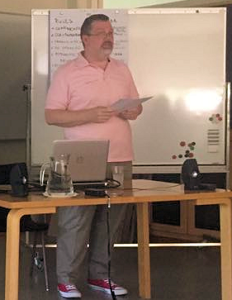
Orthodoxy, Sexuality, Gender: The State of the Conversation
Working Retreat for Orthodox LGBT Persons
Sponsored by the European Forum of LGBT Christian Groups
Helsinki, Finland
14 July 2018
Introduction
I have been tasked in today’s plenary conversation with providing an overview of the state of the Orthodox theological conversation regarding human sexuality. We only have an hour and a half for this conversation, so we cannot cover the entire history of our topic. My goal with you is to cover some of the highlights. And at the end of the presentation, I will identify some areas that I believe need further conversation within Orthodox contexts.
First, I’d like to say a few words about some recent developments in the conversation. These are highlights. I’m sure that others can add to this in our discussion.
Players
The European Forum of LGBT Christian Groups held its first seminar for Orthodox and other participants in Finland in 2015. The meeting brought together participants from Russia, Belarus, Ukraine, Poland, Romania, Belgium, India, Greece, Germany, and the United States.
When the Orthodox world came together for the Holy and Great Council of 2016, the Forum released an open letter to the bishops with an appeal on behalf of LGBT Orthodox.
The Forum subsequently gathered the materials from the first Finland seminar and the open letter into a book called For I am Wonderfully Made: Texts on Eastern Orthodoxy and LGBT Inclusion. A Russian translation was released this year.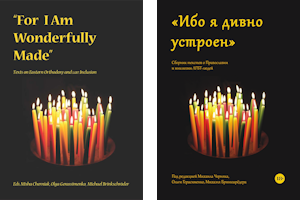
In 2016, the Oslo Coalition on Freedom of Religion or Belief (OC) began a three-year cycle of seminars under its broader program of New Directions in Orthodox Christian Thought and Practice. In its first year, participants from around the Orthodox world discussed the topic of "Same Sex Relations and Orientation." Last year, participants explored "Gender and Orthodoxy." This December, a last gathering in the series will examine how the theoretical conversations about sex and gender play out in the parish context. How can parishioners and priests engage with sexual minorities, gender minorities, women, and so forth in better ways? How might Orthodox seminaries teach students to work with gender-underprivileged groups?
In 2017, the Amsterdam Center for Orthodox Studies hosted a group of scholars and clergy for the Amsterdam Symposium on Pastoral Care and Sexuality. The group represents a variety of opinions, ranging from the more traditional to more constructive approaches. Many of their presentations are now available online. This particular meeting has drawn a great deal of outrage in the Orthodox blogosphere, primarily because of the concentration of participants drawn from St. Vladimir’s Orthodox Theological Seminary in the United States.
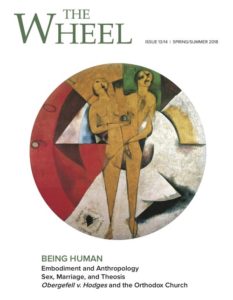 Finally, The Wheel, a privately produced journal of Orthodox thought now in its third year, released a double issue entitled Being Human just this year. Among its material, the journal published several of the papers presented at the Amsterdam Symposium. Fr. Andrew Louth served as guest editor for the issue and the foreword was contributed by Met. Kallistos Ware. Among the participants of this week’s seminar here in Finland, Gregory Tucker was a co-author for a piece and Christopher Sprecher served as proofreader for the publication.
Finally, The Wheel, a privately produced journal of Orthodox thought now in its third year, released a double issue entitled Being Human just this year. Among its material, the journal published several of the papers presented at the Amsterdam Symposium. Fr. Andrew Louth served as guest editor for the issue and the foreword was contributed by Met. Kallistos Ware. Among the participants of this week’s seminar here in Finland, Gregory Tucker was a co-author for a piece and Christopher Sprecher served as proofreader for the publication.
Contexts
What do I mean by Orthodox contexts? This can mean parish life. It can mean life in a society that officially recognizes Orthodoxy as a state religion. It can mean an academic community that values and studies the theologies of the Church Fathers and Mothers and contemporary Orthodox theologians. However, none of these pursuits are hermetically sealed environments. For all of the current Orthodox polemic about “the West” and secularism, Orthodox Christians do not exist in a vacuum. In all of these venues, we continue to live in multiple contexts with different worldviews, insights, and values. There is no pure land of Orthodoxy, nor can there be. For all of our talk of Tradition, every Orthodox Christian is a convert to Orthodoxy. Each of us is shaped over time by a life of prayer, fasting, almsgiving, corporate worship, and contemplation of the Divine. Even cultures that claim an ancient Orthodox tradition mostly do so on the basis of a discontinuous history of Orthodox cultural influences. In Eastern Europe, the fall of communism has opened the door to an increase in the numbers of Orthodox. Yet we all remain converts in a process of learning what it means to be Orthodox.
The Current State of the Conversation
Orthodox conversations about LGBTQ+ themes – and if we’re honest, we often deal with themes rather than people – are situated in broader social contexts. For many of us, this broader context includes what is commonly referred to as “the culture wars.” It is often pitched as a clash of civilizations. Or as liberals vs. conservatives. Or as secularism vs. Christendom. Rather than tackling these very large themes, I want to focus more narrowly on our topic. But to do this well, we need to step back from our immediate concern just a little in order to see that issues of sexuality are situated in a larger understanding of biological sex and gender. Thus, while our focus is on LGBTQ+ people and the realities of our lives, our topic is related to a host of questions: the roles of men and women in the Church, same-sex romantic relationships, sacramental understandings of marriage, the use of reparative therapy to move people into a heterosexual orientation, the care of transgender and intersex persons, and definitions of what constitutes a family (including adoption).
The overwhelming majority of voices within the Orthodox sphere advocate for views based on what we often refer to as gender essentialism. In this view, human beings can be divided into two distinct, fixed, and non-interchangeable categories of biological sex (male/female), gender (masculine/feminine), and gender identity (man/woman). Members of these two categories are complementary, forming pairs as husband and wife, who then procreate the next generation of human beings.
Orthodox mostly hold these views along with members of the larger society where these ideas feed into nation building, marketing, and economies. But within the Orthodox sphere, these ideas are often seen as a part of the Holy Tradition. And we back them up with selective proof texts from the Bible, from the patristic corpus, and from more recent arguments made by Orthodox theologians and bishops. These decorations give gender essentialism an air of ancient faith. We hear people say that it has been this way since the beginning of the world. And as proof, we trot out texts from the Genesis accounts of creation:
So God created humankind in his image, in the image of God he created them; male and female he created them. – Genesis 1:27
Therefore a man leaves his father and his mother and clings to his wife, and they become one flesh. – Genesis 2:24
When we read these passages through our contemporary lenses of gender essentialism and complementarity, we end up with the basis for an argument for marriage and family between opposite-sex couples. From this kernel, we then build the nuclear family as “the little church” in the words of John Chrysostom. And then we further build godly societies on the basis of these so-called “family values.”
Throughout the twentieth century, Orthodox theologians have made further arguments for gender essentialism and complementarity. In New Testament writings, the relationship between husband and wife is an image reflecting Christ and his Bride, the Church. Several theologians have gone as far as to read an analogy between the Son and the Spirit in the Holy Trinity, the two hands of the Father in the world, and man and woman, who come together to form the visible image of the invisible Father. While they are mostly careful to repeat the ancient patristic teachings that God transcends male and female, they continue to describe the work of the Son and the Holy Spirit in terms of masculine and feminine activities.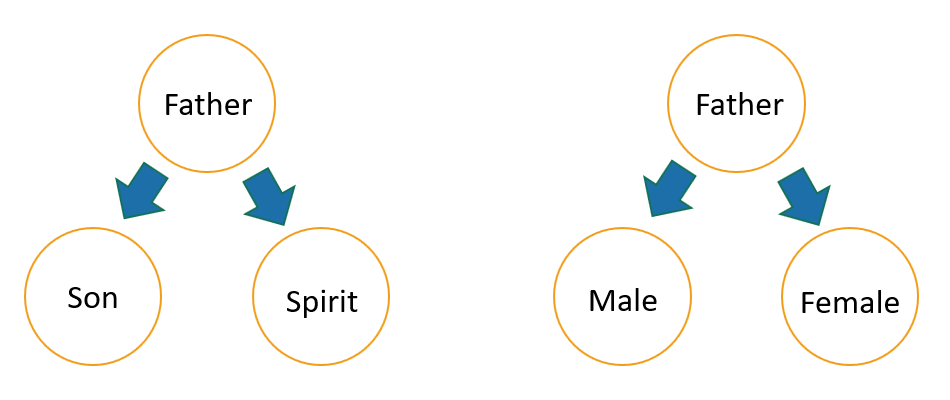
Gender essentialism, now dressed in the words of the Scriptures and the Fathers, is the basis for most of our relationships. And any person who steps outside of the expected cultural norms becomes not only socially deviant, but a sinner. And unrepentant sinners are then further labeled as heretics and apostates.
There are, of course, a few concessions. Orthodox still make exceptions for monastic vocations and make allowances for those who are not yet married among the laity. However, the pressure is strong for those who have not taken a vow of celibacy to pair off, form a family, and continue in the norm.
Theological Anthropology
The matters we have been exploring so far belong to the theological category known as theological anthropology. They provide answers to the question: What does it mean to be human, created in the image of God? The vast majority of contemporary Orthodox theological anthropologies assume gender essentialism at their core. Yet this has not always been the case.
In the early Christian context, informed by the standards of philosophical and medical ideas of the day, human beings were not viewed in the fixed gender binary that is so common to us today. Rather, Hippocratic and Galenic medicine, as well as Aristotelian thought, conceived of human beings along a scale of greater and lesser perfection.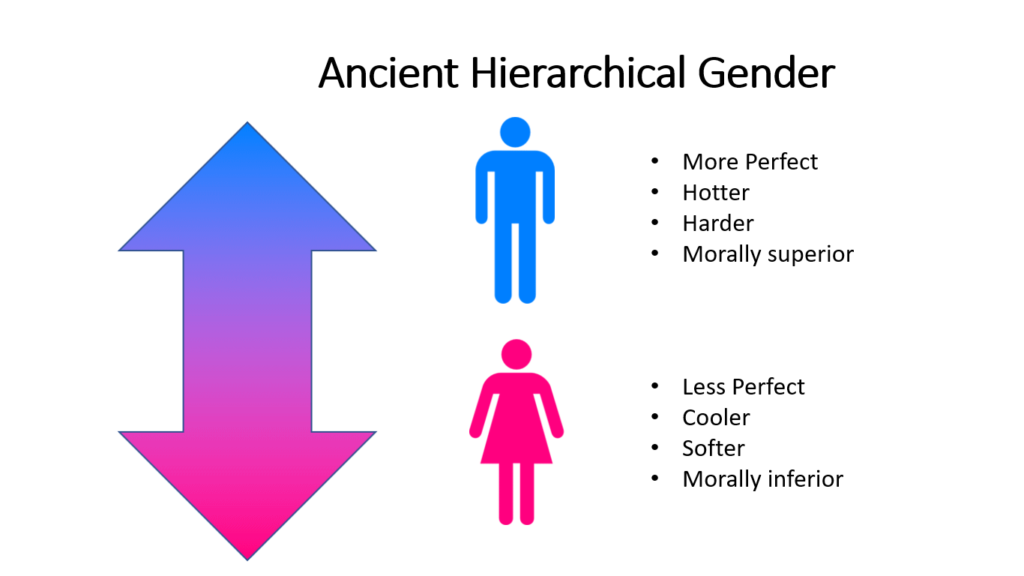
Men were considered to be more perfect specimens of humanity—stronger, harder, warmer, less moist. Women were less perfect humans who had failed to live up to the high standards of manhood. They were weaker, softer. They had less heat and more moisture. In addition to these physical differences, men were believed to be more virtuous and morally superior to women. Men lived in the world of the intellect. Women lived at the level of the material and the sensate. Men could resist temptations and passions that women could not.
The early Christian tradition held out hope for these weaker females. Through ascetic practice, they too could become manly. Early Church Fathers such as Clement of Alexandria recommended that husband and wife come together and perform their duty to procreate. And once they had produced children, they should live together as sister and brother. The woman who develops Christian knowledge is translated into a man, becoming unfeminine, manly, and perfect.
This idea continued through the centuries. Church Fathers would describe women of great faith as being female in body, but manly in their spirits. Gregory of Nyssa described his sister Macrina as being spiritually from above. John Chrysostom described Pelagia as “a woman in gender and sex, but in heart a man.” Drosis and other women like her “are made manly in martyrdom.” Domnina and her daughters, Bernice and Prosdoce had “the spirits of men” in facing their martyrdom even as they had women’s bodies. In the Latin tradition, Augustine of Hippo praises the “manly spirit” of the early Christian martyrs Perpetua and Felicitas. Perpetua’s mind, he claimed, “conceals the sex of her flesh.” Orthodox hagiographies describe women who dress in men’s clothing, join monastic communities, and live their lives presenting as men.
Other patristic authors proposed that the differences between male and female were not meant to be permanent. For example, Gregory of Nyssa grappled with the creation of male and female in Genesis and the New Testament passage in which Paul tells the Galatians that in Christ there is no “male and female.” If there is no male or female in Christ, the image of the invisible God, why is there male and female in humankind?
Gregory proposed that in the beginning, God had planned another way for humans to reach their full number. He didn’t know what it was, but he suggested it worked the same way that the angels also reached their full complement. But because God foresaw the coming Fall of humanity, God made a divine “Plan B” that included the sexing of human beings as male and female so that they could procreate to produce the full number of human beings that God had intended. Gregory and his sister Macrina theorized that eating, drinking, eliminating waste, growing to physical maturity, lactating, and sexual reproduction were all features of the “garments of skin” given to Adam and Eve as they were cast out of Eden. But in the Resurrection, our spiritual bodies would no longer include these elements. In the here and now, women might be physically different, but the Fathers affirmed that they were capable of becoming manly through the cultivation of virtue.
Some contemporary Orthodox theologians such as Elisabeth Behr-Sigel and Valerie Karras have emphasized these passages from patristic texts. Karras in particular, following patristic sources, has made the case that gender and biological sex are mere passing conditions, not a part of God’s original vision, and thus of minimal importance.
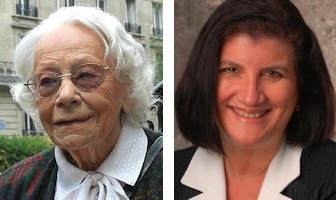
Elisabeth Behr-Sigel and Valerie Karras
Such arguments are particularly pointed at suggestions that only men can serve as a proper iconic image of Christ, excluding the possibility that women might be able to serve in the sacerdotal ranks of the Church. Appeals to the tradition and the changeable spiritual nature of masculine and feminine work well for their particular context. But they present us with two problems.
First, the appeal to ancient ideas of gender fluidity may seem like a good idea at first glance. But digging deeper, the hierarchical nature of male and female is problematic. For the Fathers and Mothers, like the rest of the broader culture in which they lived, men were superior to women, not only physically, but also morally and spiritually. Thus the idea of masculine perfection values one set of embodied experiences over another. It reinforces a gender hierarchy. And it further has a tendency to nurture misogyny. Such misogyny is a persistent feature even in the most progressive cultures. Along with its counterpart, toxic masculinity, it is responsible not only for harm to women, but also to men. It denies the unique gifts and talents of each human being by imposing an ill-fitting set of expectations. It forces people into two and only two categories. And one of those categories is often culturally constructed as being inferior or less than the other.
The second negative effect of embracing this ancient gender paradigm is that it neglects what we can learn from the broader experiences of many men and women who do not fit typical roles. This is especially true of the embodied experiences of LGBTQ+ Orthodox individuals.
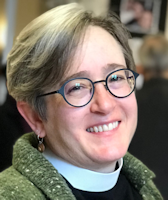
Maria McDowell
Other scholars such as Maria McDowell have critiqued the abstract idealism that erases the differences in the lived experiences of men and women in the world. I suggest that those differences also matter for lesbians, gays, and bisexuals who are attracted to people of their own biological sex. They also matter for transgender people experiencing bodily dysphoria and the pressure to conform to a gender identity and gender roles associated with their assigned biological sex. Contrary to arguments that minimize sex and gender, bodies actually do matter. Our embodied experiences are formative in who we are.
In the Image of (the Triune) God
As I’ve already mentioned, the first question of theological anthropology is: What does it mean to be a human being created in the image of God? From this first question we must ask, what is the image of God? For Gregory of Nyssa, the answer was that the rational intellect separated the human being from all other creatures. But contemporary Orthodox theologians have often taken a different path. To understand their arguments, we must first take a short look at the doctrine of the Trinity.
The Council of Nicaea I (325 CE) was the first to declare that the Father and the Son are of one being or essence. While the original Creed of Nicaea drew extensively on biblical quotations in outlining the Christian faith, it also introduced a newer word. The word was homoousios, translated as “consubstantial.” This word was not found in the Scriptures, but rather was borrowed from Greek philosophy. In claiming the full divinity of the Son, the framers of Nicaea declared that the Father and the Son were of a single divine substance. The Son is not a created being. He is instead begotten of the Father before all ages. And because he is of the same substance as the Father, he also has all of the same characteristics of divinity attributed to the Father.
With the subsequent Council of Constantinople I (381 CE), the gathered bishops approved a fuller teaching on the Holy Spirit. While the framers never applied the word homoousios to the Spirit, they used a variety of biblical quotations to point to the full divinity of the Spirit as well. In the writings of the Cappadocian Fathers, the full divinity of the Spirit was more vigorously defended. And as the Orthodox so frequently sing, we have come to know the Trinity as being one in essence and undivided.
But the Trinity is a tri-unity. While sharing the one undivided essence or being, there are still three Persons: the Father, the Son, and the Holy Spirit. There are no characteristics in their being that are unique to any of them. Yet we can in our contemplation separate the Trinity into three distinct Persons. The Fathers chose the Greek word hypostasis, a synonym for ousia borrowed from the Stoic tradition, to represent that which is unique to each Trinitarian person. While the Father, the Son, and the Holy Spirit share the same substance, they are nonetheless distinct in a few ways. The Father is neither the Son nor the Spirit. The Son is neither the Father nor the Spirit. And the Spirit is neither the Father nor the Son. How this works, no one pretends to know. It is part of the mystery of the inner life of the Trinity.
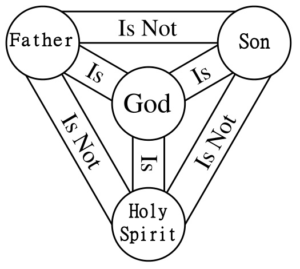 What we have then is a paradox in which two different and seemingly contradictory statements are true. The Triune God is One and Three. The Trinitarian Persons share a common and undivided substance, but are distinguishable by virtue of not being one another. This is the basis of the doctrine of the Trinity in Orthodox Christianity.
What we have then is a paradox in which two different and seemingly contradictory statements are true. The Triune God is One and Three. The Trinitarian Persons share a common and undivided substance, but are distinguishable by virtue of not being one another. This is the basis of the doctrine of the Trinity in Orthodox Christianity.
Since the end of the nineteenth century and throughout the twentieth, Orthodox theologians have suggested that human sex may be an element of our current physical form, but that beneath these forms there are masculine and feminine principles. And while some Orthodox theologians, especially of the Russian diaspora, believed that every human being contains a mixture of masculine and feminine principles, one or the other is dominant in each person. The dominant principle is responsible for the expression of biological sex. Further theologians envisioned the masculine and feminine principles as reflecting the images of Christ and the Holy Spirit. And these theologians suggested that each sex is gifted with a particular set of charisms for the work of the Church in the world.
The argument that men and women somehow serve as analogues of the Son and the Holy Spirit has been repeated regularly in Orthodox theology since the middle of the twentieth century. Father Sergius Bulgakov, building on the thought of Vladimir Soloviev, developed the idea quite fully. Bulgakov’s thought was further championed in the works of Pavel Evdokimov. And in the United States, Father Thomas Hopko, former dean of St. Vladimir’s Orthodox Theological Seminary, popularized this analogy in his writings for general Orthodox audiences. Today this idea appears repeatedly in online Orthodox discussions dealing not only with women’s ordination, but also with same-sex marriage. While selected proof texts from the Fathers are sometimes used to support these arguments, their origins are actually not within the ancient Orthodox tradition.

Gender Essentialists: Vladimir Soloviev, Fr. Sergius Bulgakov, Nikolai Berdiaev, Pavel Evdokimov, and Fr. Thomas Hopko
Gender essentialism in contemporary Orthodoxy has its roots in a variety of sources that were incorporated into nineteenth-century German Romanticism. These include the androgyne of Plato’s Symposium, ideas of preincarnate pairs of male and female souls in Jewish Kabbalah, and the writings of the German mystic Jakob Böhme. This potent mixture fueled Romantic notions of love between male and female principles that inspired Russian Orthodox thinkers such as Soloviev and Bulgakov. It also influenced the German psychoanalytic tradition of Freud and Jung that were further read into the theological anthropologies of Nikolai Berdiaev and Pavel Evdokimov. While writers such as Fr. Bulgakov name the extra-Orthodox sources that inspired their thoughts on gender, more recent Orthodox theologians who espouse these ideas appear to be oblivious to their origins.
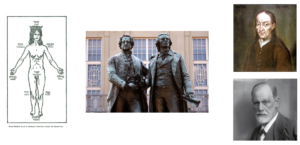
The androgynous Adam Kadmon of Lurianic Kabbalah, German Romanticism, Jakob Böhme, and Sigmund Freud
I am not suggesting that we reject gender essentialism solely on the basis of its origins in extra-Orthodox thought. As I mentioned at the beginning of this presentation, Orthodoxy does not exist within a vacuum. From the very beginning, the Fathers were often well versed in the cultural and philosophical writings of their context. Clement of Alexandria draws on the pagan literature and philosophies present in his second-century context. The Fathers of the Councils of Nicaea I and Constantinople I who worked out our dogmatic understandings of the Trinity drew terminology from Stoic and Neoplatonic ideas. Sometimes the language and ideas imported from the broader culture closely resemble their uses in the larger society from which they are drawn. Sometimes the vocabulary and concepts are modified and redeployed in new ways to express Christian sensibilities. This can also be said of Orthodoxy’s encounters with German Romanticism, as well as its interactions with other contemporary philosophical movements.
While I’m not suggesting that the gender-essentialist paradigm that correlates men with the Son and women with the Holy Spirit be rejected because of its inspiration in German Romanticism, I still propose that it be rejected. In all of its formulations, from Bulgakov to Hopko, this idea relates all women to the one hypostasis of the Spirit, while relating all men back to the one hypostasis of the Son. In the process, the uniqueness and non-interchangeability of each human person is obscured. Instead of seeing Misha and Natallia and Olga and Johan, we see only men and women. And with this comes expected roles and assumed gifts for each based not on who she or he is created to be, but rather based on whether we happen to read each as a man or a woman. A one-size-fits-all, cookie-cutter approach that denies the diversity and wonder of God’s creation.
Personalism
Alongside the twentieth-century development of the idea of male and female being analogous to the Son and the Holy Spirit within the Holy Trinity, there is another strand of Orthodox anthropology known as personalism. Orthodox theologians point to personal interactions with a personal God in the stories of Scripture to support their claims, but personalism is also a product of interactions with the German philosophical tradition and, later, the French philosophical tradition as well. Orthodox personalism is a mixture of thought that began with ninteenth-century Slavophiles, but was later augmented by scriptural references, Patristic passages, and ideas gleaned in conversation with Western sources encountered in the exile of Russian theologians and religious philosophers after the Bolshevik Revolution.
Like the ideas we just explored, Orthodox personalism also holds that human persons are analogous to Trinitarian Persons. However, rather than group all men together under the Son and all women together under the Holy Spirit, personalism sees each unique person as being undivided from the common essence, but distinguishable from all others. Persons share in the fullness of the human nature. Their absolute uniqueness appears only in relation to other persons.
To understand what we’re talking about, personalists draw a distinction between the human individual and the human person. A human individual expresses a variety of characteristics shared in common with other human individuals. This might be hair color, eye color, a particular laugh, or a way of holding one’s body. It also includes things like an individual’s skin color, reproductive organs, and secondary sex characteristics. These various expressions are a part of our common humanity. And individuals do not possess these characteristics uniquely, but rather draw them from the common human essence.
While many human individuals may share a particular characteristic, none of these characteristics are necessary to the definition of what it means to be human. Humans have many different bodily configurations. We have many different colors of hair, eyes, and skin. And our sexual organs and genetic makeups express a great deal of variety from one individual to the next. No particular characteristic is essential to what it means to be human.
In contrast, a human person is the part of a human that is not reducible to the set of characteristics held in common with others. Rather, it is the part of the human that is free from our common human nature. The part that acts in excess of our common human nature. This appears both in our interpersonal relationships and in our unique vocations within the world.
I already mentioned that theological anthropology suggests that we are created in the image of God. Contemporary anthropology suggests that there is an analogy between Trinitarian persons—Father, Son, and Spirit—and human persons. Trinitarian persons share one common divinity, so human persons share one common humanity. And just as we can distinguish between the Father, the Son, and the Spirit, we can also distinguish between Misha and Natallia and me. I am neither Misha nor Natallia. Misha is neither I nor Natallia. Natallia is neither Misha nor I. The big difference here is that there are three Trinitarian Persons, yet there appears to be an unknown number of human persons.
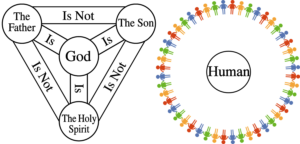 Further, each human person is unique. Each person is endowed with particular gifts for use in the Church and the world. These unique giftings are not dependent on the common human nature, including biological sex or gender. Rather, a person’s vocational call exceeds the common human nature and is unique to that person alone. No two human persons share the exact same role in the world.
Further, each human person is unique. Each person is endowed with particular gifts for use in the Church and the world. These unique giftings are not dependent on the common human nature, including biological sex or gender. Rather, a person’s vocational call exceeds the common human nature and is unique to that person alone. No two human persons share the exact same role in the world.
Implications
Contemporary Orthodox theologians have used personalist insights and the appeal to personal vocational call in response to the question of women’s ordination within the Orthodox Church. Whether the argument is over the subordination of women to men based on headship arguments, an appeal to Tradition, or the twentieth-century argument that a woman is somehow incapable of serving as an icon of Christ during the Eucharist, each argument assumes an essential difference between a male and a female nature. But according to the personalist argument, both male and female, masculine and feminine, are characteristics of our shared human essence. Each human hypostasis or person shares in that common nature. As with each of the contemporary discussions, there is a great deal more that I could say here, but we can return to this question in our discussion if we would like.
In addition to the roles of men and women within the Church, we should consider same-sex romantic relationships and the sacramental nature of marriage within the Church. An essentialist argument claims a fundamental difference between men and women that renders the two groups non-interchangeable. It is further suggested that men and women are complementary and somehow bring different gifts into a relationship. There is some truth to this argument if we look at individual couples. However, it is a mistake to assume that all women bring the same gifts or all men share the same traits.
From a personalist perspective, the complementarity in an erotic relationship is not between two sexes (male and female), but rather between two persons who are sexed. It is the persons, with their individual giftings who come together to form a couple. The partners are not interchangeable. It is not true that any other man or woman could be substituted for one of the partners to produce the same erotic relationship. Instead, each person is unique, as are the relationships each forms with other persons.
This is not to dismiss bodily differences. Indeed, our human experience shows us that the sexes of partners are highly significant in erotic and romantic bonding. For the broad majority of human beings, opposite-sex attractions are significantly more powerful than same-sex attractions. Most gay men and lesbians would also agree that the sex of their partners is quite significant. Yet regardless of an individual’s sexuality, not every individual of the sex they are most attracted to can automatically fulfill the role of an erotic interest. Each relationship is still a matter of the interactions between two unique human persons. When essentialists focus solely on the perceived biological sex of the couple, they risk reducing the persons to one characteristic, shared by all of humanity. They miss the ways that the couple can otherwise work well together.
Unlike Baptism and Eucharist, which have a very long history in Orthodox theology, marriage as a sacrament is a relative newcomer to Orthodoxy. As with all of the sacraments, marriage is seen as a vehicle for grace that leads to theosis or divine-human communion. Marriage binds the spouses together, providing opportunities to engage in self-giving love for another person. Traditionally, we have read this arrangement as an analogy for Christ and his Church. Essentialists tend to assign the Christ role to husbands and the Church role to wives. However, human persons, not human genders, enter into the sacrament of marriage. Further, the Church is made of many different people with many different sexual configurations and genders. Though it has not been a part of the Orthodox tradition, a personalist view could allow Orthodox to reimagine the self-giving love of spousal arrangements to describe the relationships between human persons without essentializing biological sex or gender.
What We Still Need
As we come to the end of this presentation, I suggest that there are three primary things that we need to move the conversation forward.
The first is an Orthodox hermeneutic for the interpretation and use of both Scripture and the Patristic tradition. The Bible (from the Greek, ta biblia) literally means “the books.” It is a collection of many different voices. They do not all say the same thing. In both the Hebrew Scriptures (or the more commonly used Greek Septuagint translation) and the New Testament, there are a variety of points of view. And they are not all saying the same thing. We must learn to listen to the dialogue. And we must join our own voices. Likewise, the Patristic writings contain a variety of different reports that do not all say the same thing. A contemporary Orthodox approach will take this into account rather than simply quoting proof-texts to support a particular point of view.
Orthodoxy also needs a more robust theological anthropology. We have only just begun to ask questions about how sex and gender relate to being human, created in the image of God. The personalist anthropology that I have outlined here provides us with a framework that can account for a wide variety of human variations without forcing unique persons into ill-fitting, essentialist categories.
Finally, we need to develop pastoral approaches for the care of LGBTQ+ persons within the Church. This is an area in which the people gathered in this room have an important role. Each person carries experiences and stories that are important to the larger conversation. Each of us has a unique set of gifts to bring to the Church.
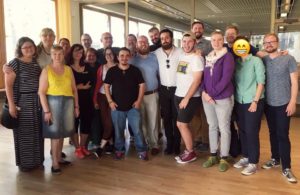
Participants in the Working Retreat for Orthodox LGBT Persons, Helsinki, Finland, 14 July 2018




Very well thought out article and beautifully written.
Wonderful information, and an even better contribution in your “signs” pointing a possible way forward from here! Many thanks!